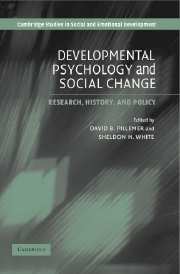Book contents
- Frontmatter
- Contents
- Preface
- List of Contributors
- Introduction: What Kind of Science Is Developmental Psychology?
- Part One The Developing Child: Global and Historical Perspectives
- Part Two Designing Child and Family Policies
- Part Three Designing Child Health Policies
- Part Four Designing Effective Learning Environments for Children and Adolescents
- 9 A Cultural/Historical View of Schooling in Human Development
- 10 The Rise of the American Nursery School: Laboratory for a Science of Child Development
- 11 Actualizing Potentials: Learning through Psychology's Recurrent Crises
- 12 The Rise of a Right-Wing Culture among German Youth: The Effects of Social Transformation, Identity Construction, and Context
- 13 Learning Potential Assessment: Where Is the Paradigm Shift?
- 14 Teaching as a Natural Cognitive Ability: Implications for Classroom Practice and Teacher Education
- Index
- References
12 - The Rise of a Right-Wing Culture among German Youth: The Effects of Social Transformation, Identity Construction, and Context
Published online by Cambridge University Press: 03 December 2009
- Frontmatter
- Contents
- Preface
- List of Contributors
- Introduction: What Kind of Science Is Developmental Psychology?
- Part One The Developing Child: Global and Historical Perspectives
- Part Two Designing Child and Family Policies
- Part Three Designing Child Health Policies
- Part Four Designing Effective Learning Environments for Children and Adolescents
- 9 A Cultural/Historical View of Schooling in Human Development
- 10 The Rise of the American Nursery School: Laboratory for a Science of Child Development
- 11 Actualizing Potentials: Learning through Psychology's Recurrent Crises
- 12 The Rise of a Right-Wing Culture among German Youth: The Effects of Social Transformation, Identity Construction, and Context
- 13 Learning Potential Assessment: Where Is the Paradigm Shift?
- 14 Teaching as a Natural Cognitive Ability: Implications for Classroom Practice and Teacher Education
- Index
- References
Summary
The Situation
In recent years the political discourse in Germany has been intensely affected by a growing awareness – in the media, the political elites and in some segments of the general public – of increasingly conspicuous neo-Nazi activity and rhetoric, especially racism, xenophobia, and anti-Semitism, and correspondingly motivated violence in young people in particular in the East of the country. The news media have reported demonstrative hostility toward foreigners, and, most spectacularly, brutal violence against those visibly different – mainly dark-skinned, but also homeless or even handicapped persons. As of September 15, 2000, the count numbered at least 93, probably 114, killed by mostly young right-wing thugs (aged 15–23) since the “transition” (Wende) in 1990. The number of 93 killed was acknowledged in September 2000 by the police, after two liberal newspapers (Tagesspiegel in Berlin and Frankfurter Rundschau) had contested the official record which had featured “a mere” 26 dead. The shift of attention, the timing and pattern of the phenomenon, the numbers, the distribution, and, most of all, the causes and explanations of the observed renascence of Nazi stereotypes and Nazi symbols are all objects of heated debates.
Nazi youth cultures are not a uniquely German phenomenon. Far-right-wing nationalist parties and racist groups are part of the political spectrum in various countries in Europe. They are voted into both national and local parliaments in France, Italy, and Austria; they play a recognizable role in Great Britain and Belgium.
- Type
- Chapter
- Information
- Developmental Psychology and Social ChangeResearch, History and Policy, pp. 314 - 351Publisher: Cambridge University PressPrint publication year: 2005
References
- 10
- Cited by



